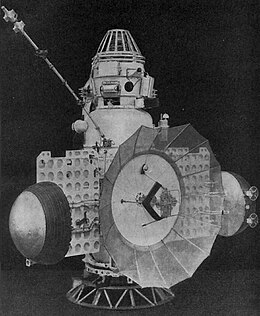Zond 3
 | |||||||||||||||
| Mission type | Lunar science | ||||||||||||||
|---|---|---|---|---|---|---|---|---|---|---|---|---|---|---|---|
| Operator | OKB-1 | ||||||||||||||
| COSPAR ID | 1965-056A | ||||||||||||||
| SATCATno. | 01454 | ||||||||||||||
| Mission duration | 228 days | ||||||||||||||
| Spacecraft properties | |||||||||||||||
| Spacecraft type | 3MV-4 | ||||||||||||||
| Manufacturer | OKB-1 | ||||||||||||||
| Launch mass | 950 kg (2,090 lb)[1] | ||||||||||||||
| Start of mission | |||||||||||||||
| Launch date | July 18, 1965, 14:32UTC[1] | ||||||||||||||
| Rocket | Molniya SL-6/A-2-e | ||||||||||||||
| Launch site | BaikonurLC-1/5 | ||||||||||||||
| End of mission | |||||||||||||||
| Last contact | March 3, 1966[2] | ||||||||||||||
| Orbital parameters | |||||||||||||||
| Reference system | Heliocentric | ||||||||||||||
| Eccentricity | 0.2683 | ||||||||||||||
| Perihelion altitude | 0.9 AU (130 million km) | ||||||||||||||
| Aphelion altitude | 1.56 AU (233 million km) | ||||||||||||||
| Inclination | 0.5° | ||||||||||||||
| Period | 500 days | ||||||||||||||
| Epoch | July 19, 1965, 20:00 UTC[3] | ||||||||||||||
| Flyby ofMoon | |||||||||||||||
| Closest approach | July 20, 1965 | ||||||||||||||
| Distance | 9,219 km (5,728 mi) | ||||||||||||||
| |||||||||||||||
Zond 3was a 1965space probewhich performed a flyby of theMoon'sfar side,[4]taking a number of quality photographs for its time. It was a member of theSovietZond programwhile also being part of the Mars3MVproject. It was unrelated to Zond spacecraft designed for crewed circumlunar missions (Soyuz 7K-L1). It is believed that Zond 3 was initially designed as a companion spacecraft toZond 2to be launched to Mars during the 1964 launch window. The opportunity to launch was missed, and the spacecraft was launched on a Mars-crossing trajectory as a spacecraft test, even though Mars was no longer attainable.
Spacecraft design[edit]
The spacecraft was of the 3MV-4 type, similar toZond 2.[2]In addition to a 106.4 mm focal lengthf/8imaging system for visible light photography andultravioletspectrometryat 285-355 μm, it carried ultraviolet (190-275 μm) andinfrared(3-4 μm)spectrophotometers,radiation sensors (gas-dischargeandscintillation counters), charged particle detector,magnetometer,andmicrometeoroiddetector.[2][5]It also had an experimentalion engine.
Operational history[edit]
Zond 3 was launched fromBaikonur Cosmodromeon July 18, 1965, at 14:38 UTC, and was deployed from aTyazhely Sputnik(65-056B) Earth-orbiting platform towards theMoonand interplanetary space. This was a repeat of a mission that failed in late 1963 intended to test communication at distances equivalent to the distances experienced by Mars and Earth.[6]
Zond 3's lunar flyby occurred on July 20 with a closest approach of 9,219 km (5,728 mi),[2]approximately 35 hours after launch. 25 visible light photographs and 3 ultraviolet spectra of very good quality were taken of the lunar surface, beginning at 01:24 UTC and 11,570 km (7,190 mi) prior to closest approach and ending at 02:32 UTC and 9,960 km (6,190 mi) past closest approach, covering a period of 68 minutes.[2][7]The photos covered 19 million km2(7.3 million sq mi) of the lunar surface.[8]
Zond 3 proceeded on a trajectory across Mars' orbit, but not at a time when planetary encounter would occur. These images were transmitted by radio frequency on July 29 at a distance of 2.25 million km (1.40 million mi). To test telemetry, the camera film was rewound and retransmitted in mid-August, mid-September, and finally on October 23 at a distance of 31.5 million km (19.6 million mi), thus proving the ability of the communications system.[2]The subsequent transmissions were also at progressively slower data rates but higher quality.[6]The mission was ended after radio contact ceased on March 3, 1966, when it was at a distance of 153.5 million km (95.4 million mi).[2][5]It operated for 228 days, roughly equivalent to the time needed to survive a journey to Mars and exceeding that needed for Venus.[2]
References[edit]
- This article was originally based on material fromNASA (NSSDC) information on Zond 3
- ^abSiddiqi, Asif (2018).Beyond Earth: A Chronicle of Deep Space Exploration, 1958–2016(PDF)(second ed.). NASA History Program Office.
- ^abcdefghLePage, Andrew J. (July 27, 2015)."The mission of Zond 3".The Space Review.
- ^"Zond 3 – Trajectory Details".NASA Space Science Data Coordinated Archive.NASA.RetrievedJune 2,2018.
- ^Harvey, Brian (August 17, 2007).Soviet and Russian Lunar Exploration.Springer Science+Business Media.p. 82.ISBN978-0-387-73976-2.
- ^abHuntress, Wesley T. Jr.; Marov, Mikhail Ya. (2011).Soviet Robots in the Solar System: Mission Technologies and Discoveries.Springer-Praxis Books in Space Exploration.Springer Science+Business Media.pp. 130–132.doi:10.1007/978-1-4419-7898-1.ISBN978-1-4419-7897-4.
- ^abTeitel, Amy Shira (July 18, 2013)."Zond 3: First to See Moon's Far Side on the Way to Mars".Discovery News.Archived fromthe originalon April 12, 2016.
- ^Siddiqi, Asif A. (June 2002).Deep Space Chronicle: A Chronology of Deep Space and Planetary Probes 1958–2000.Monographs in Aerospace History. Vol. 24. NASA. pp. 49–50.ISBN0-16-067405-0.SP-2002-4524.
- ^"Zond 3 - Details".NASA Space Science Data Coordinated Archive.NASA.RetrievedJune 2,2018.
External links[edit]
- Zond 3at Zarya.info
- Soviet Moon Imagesat Mentallandscape
| Preceded by Zond 2 |
Zond program | Succeeded by None |

